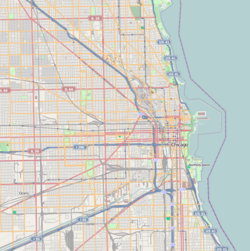Lincoln Park Lily Pool | |
 | |
| Location | Fullerton Parkway between Cannon and Stockton Drives in Lincoln Park, Chicago, IL |
|---|---|
| Area | 3 acres (1.2 ha) |
| Built | 1938 |
| Architect | Alfred Caldwell |
| Part of | Lincoln Park (ID94001029) |
| NRHP reference No. | 06000235[1] |
| Significant dates | |
| Added to NRHP | February 17, 2006 |
| Designated NHLD | February 17, 2006 |
| Designated CP | August 26, 1994 |
| Designated CL | November 6, 2002 |
The Alfred Caldwell Lily Pool, also known as Lincoln Park Lily Pool, is an important example of Prairie School landscape architecture designed by Alfred Caldwell and located at 125 W. Fullerton Parkway (between Stockton and Cannon Drives) in Lincoln Park, Chicago, Illinois. Developed in 1936-38, it is one of Caldwell's most fully realized designs.[2] It was designated a Chicago Landmark on November 6, 2002.[3] It was listed on the National Register of Historic Places and as a National Historic Landmark on February 17, 2006.[4]
YouTube Encyclopedic
-
1/5Views:1 399847947775588
-
Chicago's Lakefront | Alfred Caldwell Lily Pool
-
Alfred Caldwell Lily Pool Restoration
-
Alfred Caldwell Lily Pool, Lincoln Park
-
The Nature Boardwalk at Lincoln Park's South Pond
-
Fourteen new rowhomes in Lincoln Park
Transcription
History
A Victorian-style artificially heated lily pool had originally been built in 1889 at the behest of Lincoln Park Commission Superintendent John Pettigrew to cultivate tropical water lilies.[5][2][6] The pool area is located just north of Lincoln Park Zoo and next to the Lincoln Park Conservatory.
Features

The Rookery
In the early 1950s, under Zoo Director Marlin Perkins, the pool was transformed into a water exhibit featuring exotic birds and water fowl and came to be known as The Rookery. Overgrazing by zoo birds had a devastating effect on the lily pond. A lack of landscaping management allowed invasive plants and "weed" trees to take over the understory. Combined with heavy human foot traffic, uncontrolled erosion, the introduction of plants materials that were invasive to the existing lilies, and inappropriate repairs (eroded areas covered with loose stones) this resulted in what Caldwell called (in 1990) "a dead world".[7][8]
Renovation
From 1998 to 2002, the 2.7 acre Lily Pool underwent a major restoration by the Chicago Park District and the Lincoln Park Conservancy. The Friends of Lincoln Park (now called The Lincoln Park Conservancy) raised $1.2 million toward the restoration of the lily pools. A similar sum was obtained from a grant from the USDA Forest Service. Wolff Landscape Architecture was hired to complete the project.
Five focus groups were conducted to develop a consensus plan for restoration of the site;[9]
- experts in historic preservation,
- bird watchers and ecologists,
- Individuals knowledgeable about Lincoln Park and active in its planning and management,
- activists and experts on the subject of accessibility,
- members of the general public.
The Chicago Park District and the Lincoln Park Conservancy manage a docent program at the Caldwell Lily Pool.[10]
Location
The Lily Pool's main gate is on the south side of Fullerton Parkway between Stockton and Cannon Drives (125 W Fullerton Parkway).[7]
The Lily Pool is open seasonally from mid-April to mid-November from 7:30 a.m. to the earlier of dusk or 7:30 p.m. It is maintained by the Chicago Park District and Lincoln Park Conservancy.[10]
Free docent tours are available to the public on Fridays, Saturdays or Sundays from the Spring through Fall.[10]
-
May 2007
-
October 2010
-
Pool in Fall 2010
See also
- National Register of Historic Places listings in Chicago
- List of National Historic Landmarks in Illinois
References
- ^ "National Register Information System". National Register of Historic Places. National Park Service. January 23, 2007.
- ^ a b Julia Sniderman Bachrach; Patty Henry & Carolyn Pitts (December 2004). "National Historic Landmark Nomination: Lincoln Park Lily Pool". National Park Service. Retrieved April 20, 2017. With 12 photos.
- ^ "Alfred Caldwell Lily Pool". City of Chicago Department of Planning and Development, Landmarks Division. 2003. Archived from the original on June 13, 2008. Retrieved June 16, 2010.
- ^ "Lincoln Park Lily Pool". National Park Service. Archived from the original on January 3, 2008. Retrieved May 10, 2007.
- ^ "Lincoln Park Alfred Caldwell Lily Pool". Chicago Park District. 2006. Archived from the original on May 5, 2007. Retrieved May 10, 2007.
- ^ Grano, Laurie. "The Alfed Caldwell Lily Pool at Lincoln Park". gardendesign.com. Garden Design Magazine. Retrieved May 5, 2015.
- ^ a b Maloney, Cathy Jean (2008). Chicago Gardens:The Earliest History (first ed.). Chicago, Illinois: University of Chicago Press. pp. 464. ISBN 9780-226-502-342.
- ^ "Neglected Oasis to gain New Life When Zoo's Rookery is Renovated". chicagotribune.com. The Chicago Tribune. Retrieved May 5, 2015.
- ^ "Concept Plan for the Rehabilitation of the Lily Pool". The Lily Pool. Chicago, IL: Friends of Lincoln Park.
- ^ a b c "Alfred Caldwell Lily pool Docent Training". chicagoparkdistrict.com. Chicago Park District. Archived from the original on May 5, 2015. Retrieved May 5, 2015.
41°55′31″N 87°38′03″W / 41.9253°N 87.6341°W






